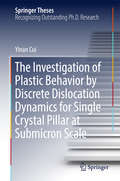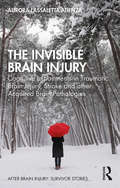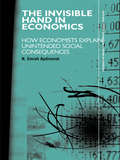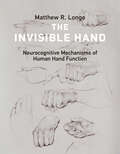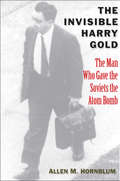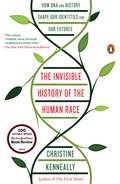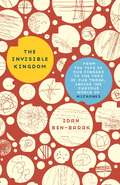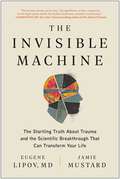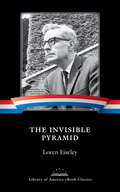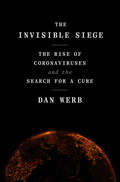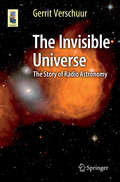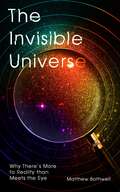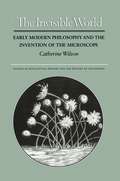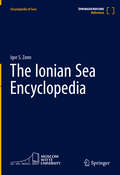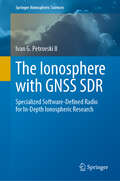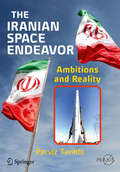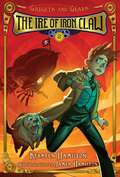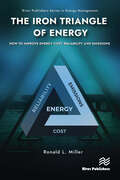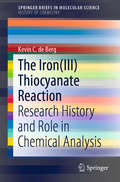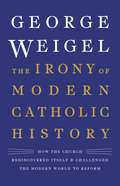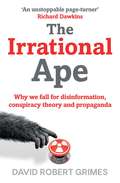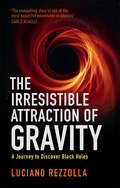- Table View
- List View
The Investigation of Plastic Behavior by Discrete Dislocation Dynamics for Single Crystal Pillar at Submicron Scale
by Yinan CuiThis thesis transports you to a wonderful and fascinating small-scale world and tells you the origin of several new phenomena. The investigative tool is the improved discrete dislocation-based multi-scale approaches, bridging the continuum modeling and atomistic simulation. Mechanism-based theoretical models are put forward to conveniently predict the mechanical responses and defect evolution. The findings presented in this thesis yield valuable new guidelines for microdevice design, reliability analysis and defect tuning.
The Invisible Brain Injury: Cognitive Impairments in Traumatic Brain Injury, Stroke and other Acquired Brain Pathologies (After Brain Injury: Survivor Stories)
by Aurora Lassaletta AtienzaThe Invisible Brain Injury recounts, in her own words, the experience of Aurora Lassaletta, a clinical psychologist who suffered a traumatic brain injury (TBI) after a traffic accident. Presenting her unique dual perspective as both a patient and a clinician, Aurora highlights the less visible cognitive, emotional and behavioural symptoms common to acquired brain injury (ABI). This moving account showcases Aurora’s growing awareness of her impairments, their manifestation in daily life, how they are perceived, or not, by others and the tools that helped her survive. Each chapter combines Aurora’s perspective with the scientific view of a professional neuropsychologist or physiatrist who provide commentaries on her various symptoms. This book is valuable reading for professionals involved in neurorehabilitation and clinical neuropsychology and for clinical psychology students. It is a must read for ABI survivors, those around them and clinicians, who are all an essential part of the rehabilitation, adjustment and acceptance process involved with ABI.
The Invisible Enemy: A Natural History of Viruses
by Dorothy CrawfordIn 1969 the US Surgeon General confidently declared, "We can now close the book on infectious diseases." The advent of AIDS has proven him spectacularly wrong, and in recent years the world has witnessed infectious outbreaks of other highly lethal viruses such as Hanta, Ebola, and Lassa fever. Flu strains are getting stronger and stronger each year. But what, exactly, is a virus? How does it work? And what is the best way to fight it? In Invisible Enemy, Dorothy Crawford offers clear answers to these and many other questions. She shows precisely how viruses, with their amazing ability to mutate, have caused devastating diseases in the past, and continue to pose one of the greatest challenges to science. A virus is disarmingly small and simple--a minute piece of genetic material wrapped in a protein coat. And yet it can cause major chaos. Smallpox killed over 300 million people in the twentieth century before it was eradicated in 1980; at that time, measles still killed two and half million children a year; and the HIV virus is now the leading cause of death in Africa. Crawford lucidly explains all aspects of these deadly parasites and discusses controversial subjects such as CFS and Gulf War Syndrome. She goes on to consider how we've coped with viruses in the past, where new viruses come from, and whether a new virus could wipe out the human race. For anyone seeking a deeper understanding of these remarkably efficient killers, Invisible Enemy provides a compelling account of their history, their effects on us, and their possible future.
The Invisible Hand in Economics: How Economists Explain Unintended Social Consequences (Routledge Inem Advances In Economic Methodology Ser.)
by N. Emrah AydinonatThis is a book about one of the most controversial concepts in economics: the invisible hand. The author explores the unintended social consequences implied by the invisible hand and discusses the mechanisms that bring about these consequences.The book questions, examines and explicates the strengths and weaknesses of invisible-hand explanations co
The Invisible Hand: Neurocognitive Mechanisms of Human Hand Function
by Matthew R. LongoHow the &“invisible hand&” of the nervous system makes the human hand such an evolutionary success.The hand has a central role in both human evolution and cultural development—in our descent and in our ascent. It is, Immanuel Kant said, &“the visible part of the brain.&” It is the invisible that concerns Matthew Longo in The Invisible Hand, a wide-ranging, deftly written account of the neural and cognitive mechanisms that have made a seemingly ordinary physical appendage an extraordinary tool in the evolution of humanity.The hand has been the focus of an enormous amount of research from a dizzying range of disciplines, from anatomy, psychology, and neuroscience to evolutionary biology and archaeology. With the concept of the invisible hand, Longo integrates and contextualizes the findings from these disparate fields to show how the neurocognitive mechanisms that comprise the invisible hand are central to understanding a wide array of phenomena, including basic sensory and motor function, space perception, gesture, and even the self. More generally, he contends that the extraordinary abilities of the hand arise precisely from the complementary nature and tight integration of the visible and invisible hands—a proposition that leads deep into topics as diverse as haptics, tool use, handedness, phantom limbs, and evolution. His work elucidates and significantly expands a key chapter of the story of human evolution and culture as manifested in the human hand.
The Invisible Harry Gold
by Allen M. HornblumIn the history of Soviet espionage in America, few people figure more crucially than Harry Gold. A Russian Jewish immigrant who spied for the Soviets from 1935 until 1950, Gold was an accomplished industrial and military espionage agent. He was assigned to be physicist Klaus Fuchs's "handler" and ultimately conveyed sheaves of stolen information about the Manhattan Project from Los Alamos to Russian agents. He is literally the man who gave the USSR the plans for the atom bomb. The subject of the most intensive public manhunt in the history of the FBI, Gold was arrested in May 1950. His confession revealed scores of contacts, and his testimony in the trial of the Rosenbergs proved pivotal. Yet among his co-workers, fellow prisoners at Lewisburg Penitentiary, and even those in the FBI, Gold earned respect, admiration, and affection. InThe Invisible Harry Gold, journalist and historian Allen Hornblum paints a surprising portrait of this notorious yet unknown figure. Through interviews with many individuals who knew Gold and years of research into primary documents, Hornblum has produced a gripping account of how a fundamentally decent and well-intentioned man helped commit the greatest scientific theft of the twentieth century.
The Invisible History of the Human Race
by Christine Kenneally* A New York Times Notable Book *"The richest, freshest, most fun book on genetics in some time." --The New York Times Book Review We are doomed to repeat history if we fail to learn from it, but how are we affected by the forces that are invisible to us? In The Invisible History of the Human Race Christine Kenneally draws on cutting-edge research to reveal how both historical artifacts and DNA tell us where we come from and where we may be going. While some books explore our genetic inheritance and popular television shows celebrate ancestry, this is the first book to explore how everything from DNA to emotions to names and the stories that form our lives are all part of our human legacy. Kenneally shows how trust is inherited in Africa, silence is passed down in Tasmania, and how the history of nations is written in our DNA. From fateful, ancient encounters to modern mass migrations and medical diagnoses, Kenneally explains how the forces that shaped the history of the world ultimately shape each human who inhabits it. The Invisible History of the Human Race is a deeply researched, carefully crafted and provocative perspective on how our stories, psychology, and genetics affect our past and our future.From the Hardcover edition.
The Invisible History of the Human Race: How DNA and History Shape Our Identities and Our Futures
by Christine KenneallyHow biology, psychology, and history shape us as individuals<P> We are doomed to repeat history if we fail to learn from it, but how are we affected by the forces that are invisible to us? In The Invisible History of the Human Race Christine Kenneally draws on cutting-edge research to reveal how both historical artifacts and DNA tell us where we come from and where we may be going. While some books explore our genetic inheritance and popular television shows celebrate ancestry, this is the first book to explore how everything from DNA to emotions to names and the stories that form our lives are all part of our human legacy. Kenneally shows how trust is inherited in Africa, silence is passed down in Tasmania, and how the history of nations is written in our DNA. From fateful, ancient encounters to modern mass migrations and medical diagnoses, Kenneally explains how the forces that shaped the history of the world ultimately shape each human who inhabits it. <P> The Invisible History of the Human Race is a deeply researched, carefully crafted and provocative perspective on how our stories, psychology, and genetics affect our past and our future.
The Invisible Kingdom: From the Tips of Our Fingers to the Tops of Our Trash, Inside the Curious World of Microbes
by Idan Ben-BarakWith the wit of Bill Bryson and the spirit of Natalie Angier, Idan Ben- Barak takes us on a fantastic voyage into the infinitesimal world of microbiology. In The Invisible Kingdom, he introduces us to the amazing lives and workings of genes, proteins, bacteria, and viruses, and the ways in which they interact to shape life on Earth. Exploring everything from radioactive waste and insect sex-change operations to the inner workings of antibiotics, Ben-Barak reveals how important these tiny critters are to all of us. He brings this largely unseen world to life with refreshing analogies and metaphors: cells "pop like bubbles” and bacteria "dream of rain. ” On the journey, we learn about the teamwork required to rot human teeth, the origins of diseases, what really goes on inside cow stomachs, and the ways in which microbes benefit human life. An infectious and informative scientific exploration, The Invisible Kingdom will change the way we see the world around us.
The Invisible Machine: The Startling Truth About Trauma and the Scientific Breakthrough That Can Transform Your Life
by Jamie Mustard Eugene LipovPenCraft Book Awards 2023 Non-Fiction Runner Up The world has long misunderstood trauma. Now, leading experts in the field have a radical new understanding of post-traumatic stress . . . and a surprising new treatment to reverse it could have profound implications for medicine, mental health, and society. Despite its prevalence, post-traumatic stress, PTSD, is often seen as an unbeatable lifelong mental disorder. However, top trauma doctors and neuroscientists now understand that the result of trauma is not a disorder, but rather a physical injury—and while invisible to the naked eye, the posttraumatic stress injury (PTSI) can now be seen on a scan. Most importantly, the effects of PTSI are reversible. Meet Dr. Eugene Lipov. His research and partnerships have led to an amazing discovery that all trauma has at its root a single piece of human hardware: the sympathetic nervous system, controlling the fight-or-flight response. Anyone who has endured trauma, including long-term microdoses of emotional stress, can have this injury. Dr. Lipov has pioneered a safe, 15-minute procedure that reverses the injury, relieving mild to extreme symptoms of PTSI—irritability, hypervigilance, anxiety, insomnia, and more—for survivors to combat soldiers to the everyday person. Weaving hard science with moving human stories, The Invisible Machine reveals how this treatment was developed. It also tells the incredible story of the unlikely team, including the doctor, an artist, Special Forces leadership, and a sheriff, who are working together to change our understanding of post-traumatic stress and why it matters to society. Coauthored by artist and innovator Jamie Mustard and in collaboration with writer Holly Lorincz, The Invisible Machine weaves hard science with moving stories of warriors, prisoners, and ordinary people to provide a stark new understanding of the human condition. The implications for a better, pain-free world are astounding—and that world could be nearer than we think.
The Invisible Pyramid
by Loren C. EiseleyThis collection of essays, first published shortly after Americans landed on the moon, explores inner and outer space, the vastness of the cosmos, and the limits of what can be known.
The Invisible Pyramid: A Library of America eBook Classic
by Loren Eiseley William CrononTo read Loren Eiseley is to renew a sense of wonder at the miracles and paradoxes of evolution and the ever-changing diversity of life. In this brilliant collection he considers the cosmological significance and ultimate meanings of our evolutionary history, offering a series of profound, lyrical meditations on the origins and possible futures of humankind against the backdrop of the Apollo landings. As Western civilization attains new heights of scientific awareness and technological skill, he asks, is it also blind to its own limits and destructive capacities? Always a fond observer of the natural world, Eiseley makes a newly urgent, environmentalist plea in The Invisible Pyramid: we must protect the fragile "world island" against our unchecked power to pollute and consume it.
The Invisible Siege: The Rise of Coronaviruses and the Search for a Cure
by Dan Werb&“A journey into the origins of COVID-19 and the discovery of vaccines and potential cures . . . I learned so much that I didn&’t know before—above all, I met the subtle warriors of the laboratory who are working to save all of us from the horror of new pandemics.&”—Richard Preston, bestselling author of The Hot Zone and The Demon in the Freezer One of Publishers Weekly&’s top ten science books of the season The urgency of the devastating COVID-19 pandemic has fixed humanity&’s gaze on the present crisis. But the story of this pandemic extends far further back than many realize. In this engrossing narrative, epidemiologist Dan Werb traces the rising threat of the coronavirus family and the attempts by a small group of scientists who worked for decades to stop a looming viral pandemic.When virologist Ralph Baric began researching coronaviruses in the 1980s, the field was a scientific backwater—the few variants that infected humans caused little more than the common cold. But when a novel coronavirus sparked the 2003 SARS epidemic, and then the MERS epidemic a decade later, Baric and his allies realized that time was running out before a pandemic strain would make the inevitable jump from animals to human hosts.In The Invisible Siege, Werb unpacks the dynamic history and microscopic complexity of an organism that has wreaked cycles of havoc upon the world for millennia. Elegantly tracing decades of scientific investigation, Werb&’s book reveals how Baric&’s team of scientists hatched an audacious plan not merely to battle COVID-19 but to end pandemics forever. Yet as they raced to find a cure, they ran into a complicated nexus of science, ethics, industry, and politics that threatened to derail their efforts just as COVID-19 loomed ever larger.The Invisible Siege is an urgent and moving testament to the unprecedented scientific movement to stop COVID-19—and a powerful look at the infuriating factors that threaten to derail discovery and leave the world vulnerable to the inevitable coronaviruses to come.
The Invisible Universe
by Gerrit VerschuurHidden from human view, accessible only to sensitive receivers attached to huge radio telescopes, the invisible universe beyond our senses continues to fascinate and intrigue our imaginations. Closer to home, in the Milky Way galaxy, radio astronomers listen patiently to the ticking of pulsars that tell of star death and states of matter of awesome densities. All of this happens out there in the universe hidden from our eyes, even when aided by the Hubble Space Telescope. This is the story of radio astronomy, of how radio waves are generated by stars, supernova, quasars, colliding galaxies and by the very beginnings of the universe itself. The author discusses what radio astronomers are doing in the New Mexico desert, in a remote valley in Puerto Rico, and in the green Pocahontas Valley in West Virginia, as well as dozens of other remote sites around the world. With each of these observatories, the scientists collect and analyze their data, "listening" to the radio signals from space in order to learn what, or perhaps who, is out there as well. The author specifically highlights enormous changes that have occurred in the field over the past 50 years, including the political reality of radio astronomy and what that could mean for the future.
The Invisible Universe: Why There's More to Reality than Meets the Eye
by Matthew BothwellFrom the discovery of entirely new kinds of galaxies to a window into cosmic &‘prehistory&’, Bothwell shows us the Universe as we&’ve never seen it before – literally. Since the dawn of our species, people all over the world have gazed in awe at the night sky. But for all the beauty and wonder of the stars, when we look with just our eyes we are seeing and appreciating only a tiny fraction of the Universe. What does the cosmos have in store for us beyond the phenomena we can see, from black holes to supernovas? How different does the invisible Universe look from the home we thought we knew? Dr Matt Bothwell takes us on a journey through the full spectrum of light and beyond, revealing what we have learned about the mysteries of the Universe. This book is a guide to the ninety-nine per cent of cosmic reality we can&’t see – the Universe that is hidden, right in front of our eyes. It is also the endpoint of a scientific detective story thousands of years in the telling. It is a tour through our Invisible Universe.
The Invisible World: Early Modern Philosophy and the Invention of the Microscope (Studies in Intellectual History and the History of Philosophy #2)
by Catherine WilsonIn the seventeenth century the microscope opened up a new world of observation, and, according to Catherine Wilson, profoundly revised the thinking of scientists and philosophers alike. The interior of nature, once closed off to both sympathetic intuition and direct perception, was now accessible with the help of optical instruments. The microscope led to a conception of science as an objective, procedure-driven mode of inquiry and renewed interest in atomism and mechanism. Focusing on the earliest forays into microscopical research, from 1620 to 1720, this book provides us with both a compelling technological history and a lively assessment of the new knowledge that helped launch philosophy into the modern era. Wilson argues that the discovery of the microworld--and the apparent role of living animalcula in generation, contagion, and disease--presented metaphysicians with the task of reconciling the ubiquity of life with human-centered theological systems. It was also a source of problems for philosophers concerned with essences, qualities, and the limits of human knowledge, whose positions are echoed in current debates about realism and instrument-mediated knowledge. Covering the contributions of pioneering microscopists (Leeuwenhoek, Swammerdam, Malpighi, Grew, and Hooke) and the work of philosophers interested in the microworld (Bacon, Descartes, Leibniz, Malebranche, Locke, and Berkeley), she challenges historians who view the abstract sciences as the sole catalyst of the Scientific Revolution as she stresses the importance of observational and experimental science to the modern intellect.
The Ionian Sea Encyclopedia (Encyclopedia of Seas)
by Igor S. ZonnThe book is dedicated to the Ionian Sea, which is part of the Mediterranean. The encyclopedia contains about 600 articles on the hydrographic and geographic objects, hydrological features of the sea, biological resources, as well as administrative-territorial units of the Ionian countries. The most significant natural objects like islands, peninsulas, bays, rivers, mountains, their geographical peculiarities are briefly described as well as economy, culture and history, cities, ports, international agreements, research institutions, activities of outstanding scientists, researchers, travelers are presented in the publication. The chronology of the main historical events that have become significant landmarks in the history of discovery and exploration of the Ionian Sea from the 31 B.C. to the present day is given.
The Ionosphere with GNSS SDR: Specialized Software-Defined Radio for In-Depth Ionospheric Research (Springer Atmospheric Sciences)
by Ivan G. Petrovski IIThis comprehensive volume navigates through the complexities of Earth's ionosphere and its intricate relationship with GNSS spread-spectrum signals. The book delineates the nuanced structures and dynamics of Earth's atmosphere, offering profound insights into signal propagation, including a meticulous analysis of various ionospheric models. Delving into the instruments of choice, it encapsulates the facets of the GNSS space segment, its theoretical background, and practical applications. The ground and user segments discussed provide readers with a deep understanding of satellite dynamics and navigation data. Further chapters explore the intricacies of GNSS Software Defined Radio (SDR), offering a detailed examination of signal acquisition and tracking, and presenting innovative approaches to baseband data application without data decoding. A significant portion is devoted to manufacturing front-end hardware, providing guidance from specifications to testing, enabling readers to navigate the world of hardware design with ease. Lastly, the book ventures into the applications of GNSS receivers for ionospheric study, highlighting the construction of advanced observables and their practical applications in navigation processors. This section also elucidates the role of multi-station observables in extracting critical ionospheric information. A pivotal resource for researchers and professionals alike, this book stands as a testament to comprehensive research and innovation in the field of GNSS and SDR, fostering a deeper understanding of the Earth's ionosphere. This book serves as a natural progression from Dr.Petrocski's prior contributions, offering readers actionable insights grounded in theoretical understanding.
The Iranian Space Endeavor
by Parviz TarikhiProvides a detailed look at the events and policies surrounding the Iranian space endeavor. For those who see the trend of progress and movement of the Iranian space endeavor from the outside, it can be difficult to understand what goes on behind the scenes. However, for one who observes these events firsthand, they take on a very different meaning. In this book, the author brings new and different profiles of Iran's space endeavor to light. Iran claims to be the ninth leading country in the world capable of manufacturing satellites and launching them, plans to land an astronaut on the Moon within a decade, and says its own president plans to be the first Iranian astronaut to travel into space. The author explains in this book that not all of these claims are quite as they seem. In addition to technical explanations, the book also includes historical, legal, social and cultural aspects of Iran's space program as well. It is the author's goal to create a tangible feeling of Iran's space endeavor for the readers.
The Ire of Iron Claw
by James Hamilton Kersten HamiltonSomeone is smuggling secrets out of the Kennewicketts' lab and sabotaging their experiments, putting everyone at the Amazing Automated Inn at risk. In pursuit of the villains, the family of scientific geniuses board their dirigible and take to the skies. Together with their robotic staff and the inventor Nikola Tesla, they must face murderous sky pirates, cross the Alps in a giant mechanical spider, and defy the perilous pigeon Iron Claw and the malevolent magician Madini once more. Will boy inventor Wally and his daring dog, Noodles, be able to defeat the evil Mesmers and their minions a second time? History and technology collide in this fast-paced series narrated by a daring dachshund and brimming with mad science.
The Iron Triangle of Energy: How to Improve Energy Cost, Reliability, & Emissions (River Publishers Series in Energy Management)
by Ronald L. Miller"The Iron Triangle of Energy" explores the intricate balance between cheap, reliable, and clean energy. In a world of trade-offs, this book provides rational ideas to optimize energy choices. With a focus on education and mentoring, it equips consumers, students, industry, and government with the knowledge needed to make informed decisions for our future. Rich with pertinent graphs, it offers a clear understanding of key energy issues.
The Iron: Research History and Role in Chemical Analysis (SpringerBriefs in Molecular Science)
by Kevin C. de BergThis Brief presents an historical investigation into the reaction between ferric ions and thiocyanate ions, which has been viewed in different ways throughout the last two centuries. Historically, the reaction was used in chemical analysis and to highlight the nature of chemical reactions, the laws of chemistry, models and theories of chemistry, chemical nomenclature, mathematics and data analysis, and instrumentation, which are important ingredients of what one might call the nature of chemistry. Using the history of the iron(III) thiocyanate reaction as a basis, the book’s main objective is to explore how chemistry develops its own knowledge base; how it assesses the reliability of that base; and how some important tools of the trade have been brought to bear on a chemical reaction to achieve understanding, a worthwhile goal of any historical investigation.
The Irony of Modern Catholic History: How the Church Rediscovered Itself and Challenged the Modern World to Reform
by George WeigelA powerful new interpretation of Catholicism's dramatic encounter with modernity, by one of America's leading intellectualsThroughout much of the nineteenth century, both secular and Catholic leaders assumed that the Church and the modern world were locked in a battle to the death. The triumph of modernity would not only finish the Church as a consequential player in world history; it would also lead to the death of religious conviction. But today, the Catholic Church is far more vital and consequential than it was 150 years ago. Ironically, in confronting modernity, the Catholic Church rediscovered its evangelical essence. In the process, Catholicism developed intellectual tools capable of rescuing the imperiled modern project. A richly rendered, deeply learned, and powerfully argued account of two centuries of profound change in the church and the world, The Irony of Modern Catholic History reveals how Catholicism offers twenty-first century essential truths for our survival and flourishing.
The Irrational Ape: Why Flawed Logic Puts us all at Risk and How Critical Thinking Can Save the World
by David Robert Grimes'A beautifully reasoned book about our own unreasonableness' Robin Ince Why did revolutionary China consider the sparrow an 'animal of capitalism' - and what happened when they tried to wipe them out? With a cast of murderous popes, snake-oil salesmen and superstitious pigeons, find out why flawed logic puts us all at risk, and how critical thinking can save the world. It may seem a big claim, but knowing how to think clearly and critically has literally helped save the world. In September 1983, at the height of the Cold War, the Soviet Union's early warning system showed five US missiles heading towards the country. Stanislaw Petrov knew his duty: he was to inform Moscow that nuclear war had begun, so that they could launch an immediate and devastating response. Instead, he made a call to say the system was faulty. He'd assessed the situation and reasoned that an error was more likely than such a limited attack. We may not have to save the planet from nuclear annihilation, of course, but our ability to think critically has never been more important. In a world where fake news, mistrust of experts, prejudice and ignorance all too often hold sway, we can all too easily be misled over issues such as vaccinations, climate change or conspiracy theories. We live in an era where access to all the knowledge in the world is at our fingertips, yet that also means misinformation and falsehoods can spread further and faster than ever before. In The Irrational Ape, David Robert Grimes shows how we can be lured into making critical mistakes or drawing false conclusions, and how to avoid such errors. Given the power of modern science and the way that movements can unite to protest a cause via social media, we are in dangerous times. But fortunately, we can learn from our mistakes, and by critical thinking and scientific method we can discover how to apply these techniques to everything from deciding what insurance to buy to averting global disaster. This book, packed with fascinating case studies and examples, helps ensure we are ready for the modern world.
The Irresistible Attraction of Gravity: A Journey to Discover Black Holes
by Luciano RezzollaThe mystery of gravity has captivated us for centuries. But what is gravity and how does it work? This engaging book delves into the bizarre and often counter-intuitive world of gravitational physics. Join distinguished astrophysicist Professor Luciano Rezzolla on this virtual journey into Einstein's world of gravity, with each milestone presenting ever more fascinating aspects of gravitation. Through gentle exposure to concepts such as spacetime curvature and general relativity, you will discover some of the most curious consequences of gravitational physics, such as black holes, neutron stars and gravitational waves. The author presents and explains one of the most impressive scientific achievements of recent times: the first image of a supermassive black hole. Written by one of the key scientists involved in producing these results, you'll get a behind-the-scenes view of how the image was captured and discover what happens to matter and light near a black hole.
